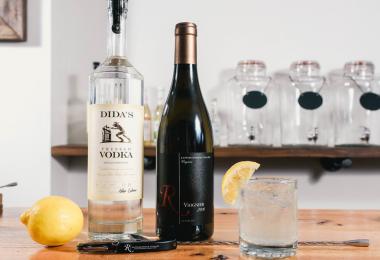On a Sunday afternoon in early April, Bordeaux’s Cité du Vin, which rises from the Garonne River waterfront like a giant silver snail 10 storeys high, is teeming with visitors, sampling both the interactive exhibitions about international wine culture and wines from around the world. A few steps away, an ocean-going cruise ship unloads more visitors for an overnight visit. In 2017, its first full year, the Cité drew almost half a million visitors, 23 per cent from outside of France. It looks likely to exceed that number this year.
The following day, Didier Gontier, who heads the Côtes de Bourg winegrowers’ association, shows off his organisation’s own showplace — the Maison des Vin on a hillside overlooking the Dordogne. Bourg is a bit off the beaten track, one of the lesser known of the Bordeaux region’s 60 or so sub-appellations. Therefore the tasting facility is a crucial gathering point for visitors who come by bus and boat.
On Tuesday morning, Marion Merker, wine tourism manager for the historic Château de la Dauphine in Fronsac, briefly excuses herself from a discussion about the importance of wine tourism and the more than 5,000 visitors the château welcomes annually. “I’m sorry,” she explains, “but I have a group of 41 French tourists who I have to say hello to.”
Tourism is booming in Bordeaux, as it is in most major wine areas of the world. Increasingly, the world’s wine drinkers — Americans in particular — want not only to enjoy wine, but also to experience its provenance. Catherine Leparmentier is managing director of Bordeaux-based Great Wine Capitals, an organisation of 10 cities located in major wine regions on five continents. “We had 7m visitors to Bordeaux last year,” she says, “and that number has almost tripled from the 2.5m who came in 2005.” The bottom line, she reports, is that in 2016 Bordeaux tourism netted about €1.8bn ($2.2bn) to support the local economy.
The Cité du Vin, which is run by a non-profit foundation with no public funding, generates €38m ($46.4m) in economic activity annually, creating about 750 jobs, 250 of which are directly employed. Not only are tourists important to hotels, restaurants and shops, but they also buy thousands of cases of wine. They return to their home towns as enthusiastic brand ambassadors for the region.
Changing attitudes
A generation ago, wine tourism, especially in the somewhat socially conservative French south-west where Bordeaux is located, was still an oddity. Perhaps typical of the region’s insularity were comments between two directors of major estates in the Médoc visiting New York about a dozen years ago. When asked what wines they drank other than their own, one said: “Perhaps our neighbours’ — if we get along with them.” The other nodded in agreement.
Of course, châteaux were always open to trade visits from importers, wholesalers and major retailers. Occasionally, a very good customer would fax a château a letter of introduction from his or her wine merchant and a visit would be agreed upon well in advance of the trip. Moreover, lodging was scarce throughout the region and trying to find food on a Sunday afternoon was nearly impossible. Near the end of the 20th century, however, a few prominent Bordeaux wine families saw an opportunity to change things. One was the Cazeses, whose prize holding is Château Lynch-Bages in Pauillac, led at the time by Jean-Michel Cazes, a former insurance executive, and his sister, Sylvie Cazes. In 1989, the Cazeses opened the nearby Château Cordeillan-Bages as an upscale small hotel with a gourmet restaurant. In 2003, the family went further in reconstructing the old village of Bages just behind their winery, converting it into fashionable eating and shopping venue.
Meanwhile, in the quiet town of Léognan south of Bordeaux city, Daniel and Florence Cathiard, former members of the French national ski team and later supermarket magnates, bought the ailing Château Smith Haut Lafitte in 1990. They shocked their neighbours by deciding not only to make great wine but also to be a leader in the emerging oenotourism industry. Along with their two daughters, they opened Les Sources de Caudalie in 1999. Caudalie included a glamorous hotel, a Michelin-starred restaurant and a spa that featured treatments using grape seeds and pomace, which itself grew into a worldwide cosmetics and hospitality venture.
Another wealthy entrepreneur Bernard Magrez, owner of Château Pape Clément on the southern edge of Bordeaux city, also amassed a collection of tourist-friendly estates and hospitality endeavors.
Today, it’s not just the prominent Bordelais who welcome tourists — the whole of Bordeaux is open.
Building the infrastructure
From her office overlooking the Place de la Bourse on the Bordeaux waterfront, Leparmentier has seen the changes that have taken place in the city since she helped found the Great Wine Capitals organisation in the 1999. Among other things has been the revitalisation of the once-drab metropolis that tourists a decade ago usually ignored in search of vineyards. “Every day,” Leparmentier says, “I look out my window and see dozens of people of all ages and backgrounds enjoying the Water Mirror.” The “Miroir d’Eau” is a slab of granite covered by 3cm of water that rhythmically changes from moment to moment. In less than a decade, it has become the city’s most-photographed site.
The mirror and the riverside park and walkways around it are indicative of the huge amount of infrastructure investments that the city of Bordeaux and its merchants have made, not only to entice tourism but also to attract permanent residents. Its historic but outdated waterfront was cleared of old warehouses and its classic and neoclassic structures were power-washed to remove years of grey-black grime. A centerpiece has been the above-ground tram system that first opened in late 2003 and now has more than 43 miles of tracks, including easy links to the main train station, Gare Saint-Jean, of which a three-year major overhaul was completed in 2017. High-speed TGV trains have long connected Bordeaux with Paris and its main airport, Charles de Gaulle, but last year a new TGV began making direct runs between Bordeaux and Paris’s Gare Montparnasse, taking only two hours.
All this groundwork was completed before the opening of the pièce de résistance, the Cité du Vin. Mayor Alain Juppé, who knows how to turn a sound bite or two, proclaimed that “la Cité du Vin will be my Guggenheim!” referring to the Frank Gehry-designed museum that re-energised downtown Bilbao.
It is no surprise that the person who heads the non-profit foundation responsible for building and running the museum is the energetic Sylvie Cazes. A few years ago she left the Cazes family business to run her own château in St-Émilion (Chauvin), start a major travel company (Bordeaux Saveurs) and serve as head of various trade and civic organizations, including the Cité’s Fondation pour la Culture et les Civilisations du Vin. “The idea for the Cité had its origins about 20 years ago, but at the time winegrowers decided not to fund it,” says Cazes. “Having a successful world trade fair, Vinexpo, in Bordeaux gradually got people interested again.” Cazes says that local winegrowers supported the idea of making the wine experience an international one, in which the world’s wine regions can even finance their own temporary exhibitions. The building cost of €81m ($99m) was privately funded and the venue is already profitable.
Diversifying the offer
Wine tourism goes well beyond visits to barrel cellars and tasting rooms. When Château Le Pape was up for sale, Véronique Sanders, managing director of nearby Château Haut-Bailly — a respected and tourist-friendly estate in Léognan — bought it not only for its vineyards, but also to turn its quaint estate house into a bed-and-breakfast. “My grandfather always believed in welcoming visitors to our châteaux,” she says.
Today, there is enthusiastic competition among châteaux great and small for tourism awards presented by the Bordeaux chapter of the Great Wine Capitals, which also conducts similar tourism contests in its other nine cities — Adelaide, Bilbao, Mainz, Mendoza, Porto, San Francisco, Valparaiso, Verona and its newest member, Lausanne. Château de Rayne Vigneau, for example, won for its treetop tasting experience that gives an unparalleled view of the surrounding Sauternes countryside. Château de Siran was a winner for its 300-piece wine art collection. Château d’Agassac took an award for its restaurant — one of many fine restaurants in Bordeaux, some Michelin-starred.
Tourism companies — from multi-day cultural experiences of Cazes’ Saveurs to BordoVino, which specialises in half-day, two-châteaux, €69.00 ($84.00) ventures as well as bike tours — have broadened their offerings to include both local and nearby non-wine attractions. Chief among these is the beach town of Arcachon, with its beaches, sailing bay and oysters. Caverns with prehistoric paintings are a day trip away in Dordogne. Cooking classes and visits to farmers’ markets abound in Entre-Deux-Mers. St-Émilion has its limestone catacombs running under the vineyards. Cognac is a couple of hours away.
Visitors who arrive by cruise ships — the slow trip up the Gironde estuary dictates an overnight stay — love to take river cruises on the Garonne tributary. Moreover, the region tries to share the wealth by directing tourism efforts to the lesser-known appellations such as Bourg, Blaye, Entre-Deux-Mers and the satellite appellations surrounding St-Émilion, itself a World Heritage site.
Anticipating the pushback
As residents of any popular destination know, tourism comes with its own headaches. The trams are as packed as New York subways during rush hours. The rocade that circles the city seldom has its speed limits tested and traffic backups are common. Many new, high-end apartments are being built, while the lack of affordable housing in the city is becoming a problem.
But the Bordeaux Wine Council (the Conseil Interprofessionnel du Vin de Bordeaux or CIVB) makes efforts to publicise all its regions, which helps decentralise the impact of tourism. Private investors have located their upscale hotels and restaurants in rural as well as urban settings.
Additionally, the most highly regarded wineries — such as Châteaux Lafite Rothschild and Latour in Pauillac, Haut-Brion within Bordeaux city limits, the cliff-dwelling Ausone on the edge of St-Émilion and Petrus on the backside of Pomerol — are all many miles apart, as any writer with a tight appointments schedule quickly discovers.
“We must be a destination to attract visitors with both our wines and activities, says Xavier Planty, director and part-owner of Château Guiraud in Sauternes, which recently opened a beautiful new restaurant. “We have created an organisation between Pessac-Léognan, Graves and Sauternes [all located south of Bordeaux city] to promote our Rue de Vin,” he adds, noting that this southern region is playing catch-up with the Médoc and St-Émilion for the tourist dollar. “We still have a lot to communicate.”








